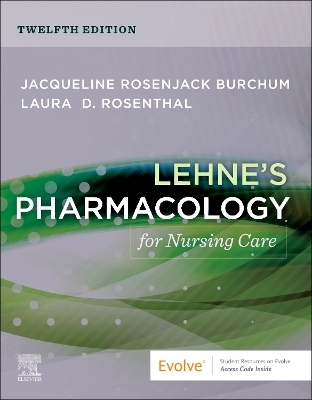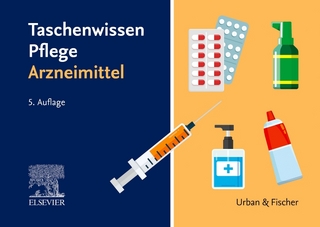
Lehne's Pharmacology for Nursing Care
Churchill Livingstone (Verlag)
978-0-443-10710-8 (ISBN)
Clear, engaging writing style simplifies complex concepts, making difficult pharmacology content not only understandable but actually enjoyable.
Prototype Drugs approach focuses on representative agents that characterize all members of a given drug group, so that you can apply your understanding to related drugs that are currently available and those that will be released in the future.
Nursing implications of drug therapy are integrated throughout to show the relationship between drug therapy and nursing care, and also recapped in Summary of Major Nursing Implications sections.
Special Interest Topic boxes examine the everyday impact of pharmacology with engaging vignettes such as Vaping and Severe Acute Respiratory Syndrome Coronavirus-2 (COVID-19) Vaccine.
Safety Alerts call out important safety concerns related to contraindications, adverse effects, and more.
Concise drug summary tables present key information for individual drugs, including drug class, generic and trade names, dosages, routes, and indications.
Person-Centered Care Across the Life Span tables summarize safe and appropriate care for patients from infancy to older adulthood.
NEW! Updated drug content includes the latest FDA drug approvals, withdrawals, and therapeutic uses, along with updated nursing content.
NEW Transgender Health chapter covers gender-affirming hormone treatment for transgender patients.
NEW! The six cognitive skills of NCSBN's Clinical Judgment Measurement Model are integrated into the Application of Pharmacology in Nursing Practice chapter and in Summary of Major Nursing Considerations tables.
NEW! Enhanced emphasis on diversity, equity, and inclusion features updated gender-neutral language.
NEW! Updated COVID-19 content addresses the latest vaccination information and pharmacotherapeutic implications.
NEW coverage of CBD and expanded coverage of medical marijuana discusses the growing use of these substances.
NEW resources for the Next-Generation NCLEX® Examination (NGN) are included on the Evolve website and in the companion Study Guide.
Assistant Dean for DNP Programs, College of Nursing, University of Colorado Anschutz Medical Campus, Aurora, Colorado
UNIT I: INTRODUCTION
1. Orientation to Pharmacology
2. Application of Pharmacology in Nursing Practice
3. Drug Regulation, Development, Names, and Information
UNIT II: BASIC PRINCIPLES OF PHARMACOLOGY
4. Pharmacokinetics
5. Pharmacodynamics
6. Drug Interactions
7. Adverse Drug Reactions and Medication Errors
8. Individual Variation in Drug Responses
9. Genetic and Genomic Considerations
10. Introduction to Immunomodulators
UNIT III: DRUG THERAPY ACROSS THE LIFE SPAN
11. Drug Therapy During Pregnancy and Breastfeeding
12. Drug Therapy in Pediatric Patients
13. Drug Therapy in Older Adults
UNIT IV: PERIPHERAL NERVOUS SYSTEM DRUGS
SECTION 1: Introduction
14. Basic Principles of Neuropharmacology
15. Physiology of the Peripheral Nervous System
SECTION 2: Cholinergic Drugs
16. Muscarinic Agonists
17. Muscarinic Antagonists
18. Cholinesterase Inhibitors and Their Use in Myasthenia Gravis
19. Drugs that Block Nicotinic Cholinergic Transmission
SECTION 3: Adrenergic Drugs
20. Adrenergic Agonists
21. Adrenergic Antagonists
22. Indirect-Acting Antiadrenergic Agents
UNIT V: CENTRAL NERVOUS SYSTEM DRUGS
SECTION 4: Introduction
23. Introduction to Central Nervous System Pharmacology
SECTION 5: Drugs for Neurodegenerative Disorders
24. Drugs for Parkinson Disease
25. Drugs for Alzheimer Disease
26. Drugs for Multiple Sclerosis
SECTION 6: Neurologic Drugs
27. Drugs for Seizure Disorders
28. Drugs for Muscle Spasm and Spasticity
SECTION 7: Drugs for Pain
29. Local Anesthetics
30. General Anesthetics
31. Opioid Analgesics, Opioid Antagonists, and Nonopioid Centrally Acting Analgesics
32. Pain Management in Patients with Cancer
33. Drugs for Headache
SECTION 8: Psychotherapeutic Drugs
34. Antipsychotic Agents and Their Use in Schizophrenia
35. Antidepressants
36. Drugs for Bipolar Disorder
37. Sedative-Hypnotic Drugs
38. Management of Anxiety Disorders
39. Central Nervous System Stimulants and Attention-Deficit/Hyperactivity Disorder
SECTION 9: Substance Use Disorders
40. Substance Use Disorders I: Basic Considerations
41. Substance Use Disorders II: Alcohol
42. Substance Use Disorders III: Nicotine
43. Substance Use Disorders IV: Major Drugs of Abuse other Than Alcohol and Nicotine
UNIT VI: DRUGS THAT AFFECT FLUID AND ELECTROLYTE BALANCE
44. Diuretics
45. Agents Affecting the Volume and Ion Content of Body Fluids
UNIT VII: DRUGS THAT AFFECT THE HEART, BLOOD VESSELS, AND BLOOD
46. Review of Hemodynamics
47. Drugs Acting on the Renin-Angiotensin-Aldosterone System
48. Calcium Channel Blockers
49. Vasodilators
50. Drugs for Hypertension
51. Drugs for Heart Failure
52. Antidysrhythmic Drugs
53. Drugs That Help Normalize Cholesterol and Triglyceride Levels
54. Drugs for Angina Pectoris
55. Anticoagulant, Antiplatelet, and Thrombolytic Drugs
56. Management of ST-Elevation Myocardial Infarction
57. Drugs for Hemophilia
58. Drugs for Deficiency Anemias
59. Hematopoietic Agents
UNIT VIII: DRUGS FOR ENDOCRINE DISORDERS
60. Drugs for Diabetes Mellitus
61. Drugs for Thyroid Disorders
62. Drugs Related to Hypothalamic and Pituitary Function
63. Drugs for Disorders of the Adrenal Cortex
UNIT IX: REPRODUCTIVE HEALTH
64. Estrogens and Progestins: Basic Pharmacology and Noncontraceptive Applications
65. Birth Control
66. Drug Therapy of Infertility
67. Drugs That Affect Uterine Function
68. Androgens
69. Drugs for Erectile Dysfunction and
Benign Prostatic Hyperplasia
70. Transgender Health
UNIT X: ANTI-INFLAMMATORY, ANTIALLERGIC, AND IMMUNOLOGIC DRUGS
71. Review of the Immune System
72. Childhood Immunization
73. Immunosuppressants
74. Antihistamines
75. Cyclooxygenase Inhibitors: Nonsteroidal Anti-inflammatory Drugs and Acetaminophen
76. Glucocorticoids in Nonendocrine Disorders
UNIT XI: DRUGS FOR BONE AND JOINT DISORDERS
77. Drug Therapy for Rheumatoid Arthritis
78. Drug Therapy of Gout
79. Drugs Affecting Calcium Levels and Bone Mineralization
UNIT XII: RESPIRATORY TRACT DRUGS
80. Drugs for Asthma and Chronic Obstructive Pulmonary Disease
81. Drugs for Allergic Rhinitis, Cough, and Colds
UNIT XIII: GASTROINTESTINAL DRUGS
82. Drugs for Peptic Ulcer Disease
83. Laxatives
84. Other Gastrointestinal Drugs
UNIT XIV: NUTRITION AND COMPLIMENTARY THERAPY
85. Vitamins
86. Drugs for Weight Loss
87. Complementary and Alternative Therapy
UNIT XV: THERAPY OF INFECTIOUS DISEASES
88. Basic Principles of Antimicrobial Therapy
89. Drugs That Weaken the Bacterial Cell Wall I: Penicillins
90. Drugs That Weaken the Bacterial Cell Wall II: Other Drugs
91. Bacteriostatic Inhibitors of Protein Synthesis: Tetracyclines, Macrolides, and Others
92. Aminoglycosides: Bactericidal Inhibitors of Protein Synthesis
93. Sulfonamide Antibiotics and Trimethoprim
94. Drug Therapy for Urinary Tract Infections
95. Antimycobacterial Agents: Drugs for Tuberculosis
96. Miscellaneous Antibacterial Drugs: Fluoroquinolones, Metronidazole, Daptomycin, Rifampin, Rifaximin, and Fidaxomicin
97. Antifungal Agents
98. Antiviral Agents I: Drugs for Non-HIV Viral Infections
99. Antiviral Agents II: Drugs for HIV Infection and Related Opportunistic Infections
100. Drug Therapy for Sexually Transmitted Infections
101. Antiseptics and Disinfectants
UNIT XVI: CHEMOTHERAPY OF PARASITIC DISEASES
102. Anthelmintics
103. Antiprotozoal Drugs I: Antimalarial Agents
104. Antiprotozoal Drugs II: Miscellaneous Agents
105. Ectoparasiticides
UNIT XVII: CANCER CHEMOTHERAPY
106. Basic Principles of Cancer Treatment
107. Anticancer Drugs I: Cytotoxic Agents
108. Anticancer Drugs II: Hormonal Agents, Targeted Drugs, and Other Noncytotoxic Anticancer Drugs
UNIT XVIII: MISCELLANEOUS DRUGS AND THERAPIES
109. Dr for the Eye Conditions and Diseases
110. Drugs for Skin Conditions
111. Drugs for Ear Conditions
UNIT XIX: TOXICOLOGY
112. Management of Poisoning
113. Potential Weapons of Biologic, Radiologic, and Chemical Terrorism
APPENDIX A: Canadian Drug Information
APPENDIX B: Prototype Drugs and Their Major Uses
Index
| Erscheinungsdatum | 08.02.2024 |
|---|---|
| Verlagsort | London |
| Sprache | englisch |
| Maße | 216 x 276 mm |
| Gewicht | 2970 g |
| Themenwelt | Medizin / Pharmazie ► Pflege ► Ausbildung / Prüfung |
| ISBN-10 | 0-443-10710-6 / 0443107106 |
| ISBN-13 | 978-0-443-10710-8 / 9780443107108 |
| Zustand | Neuware |
| Haben Sie eine Frage zum Produkt? |
aus dem Bereich


